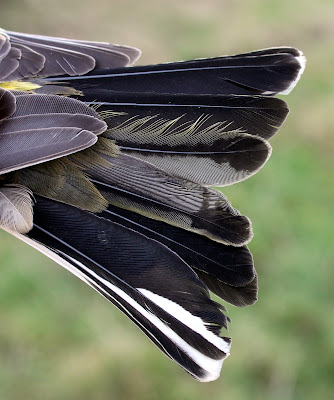When I went to top up the feeding station again, the moss was very quiet. The morning started on a high with a dawn-hunting Barn Owl at Town End and a Little Owl sat motionless in one of its regular spots.
The niger feeders were still full from my last visit and Goldfinches generally absent, although the ground feed had mostly disappeared. I caught one of the scoundrels responsible for hoovering up the seed, a second year Woodpigeon. Just five other birds captured - singles of Robin, Chaffinch, Blackbird, Great Tit and Blue Tit until I packed up out of sheer boredom.
Woodpigeon
The birding on the farm was slightly better, and in no particular order, 40+ Chaffinch, 2 Brambling, 4 Goldfinch, 40 Tree Sparrow, 9 Skylark, 1 Mistle Thrush, 6 Reed Bunting, 2 Great-spotted Woodpecker, 400+ Woodpigeon, 1 Song Thrush, 2 Yellowhammer, 5 Corn Bunting, 2 Kestrel and 1 Buzzard. Animals: 5 Roe Deer and 5 Brown Hare.
The Kestrel was a bit distant in today’s grey light. Standing on a source of light might make the job easier - the Kestrel, not me.
Kestrel
Kestrel
On a less happy note, and I’ve mentioned this on the blog before, when I check the stats and sources of blog visits, Another Bird Blog is still receiving occasional viewings from people who are either involved in the illegal catching of wild birds or seeking the whys and wherefores of how to take part.
In particular the searches generally include the word “Goldfinch”, as in a recent Google search using the words “cage to trap goldfinch” or one of a few weeks ago “best places to catch goldfinch”.
Because my blog uses “tag” words, and “Goldfinch” features regularly in the course of my posts, the searches include my blog in the results and these people then visit my blog thinking it may contain the information they seek. Of course the information on Another Bird Blog or any other UK birding and ringing blogs will not help them in any way, but these would-be wildlife criminals will continue to view all the results of their search until they eventually find the bits of information they seek. I have reported the IP address of the latest miscreant, and I urge other blog owners to do the same should they be troubled by similar things.
Goldfinch
I comment on this again so as to make bird lovers aware that the illegal catching and selling of wild birds takes place in many parts of the UK, often among the immigrant communities. If anyone should encounter the catching, selling, buying or breeding of birds which they suspect to be of wild origin, and this can be Goldfinch, Redpoll, Chaffinch, Linnet and Bullfinch plus others, they should report it to the Police and/or the RSPB/RSPCA immediately.
More lawful news and views on Another Bird Blog soon - stay tuned.














































































